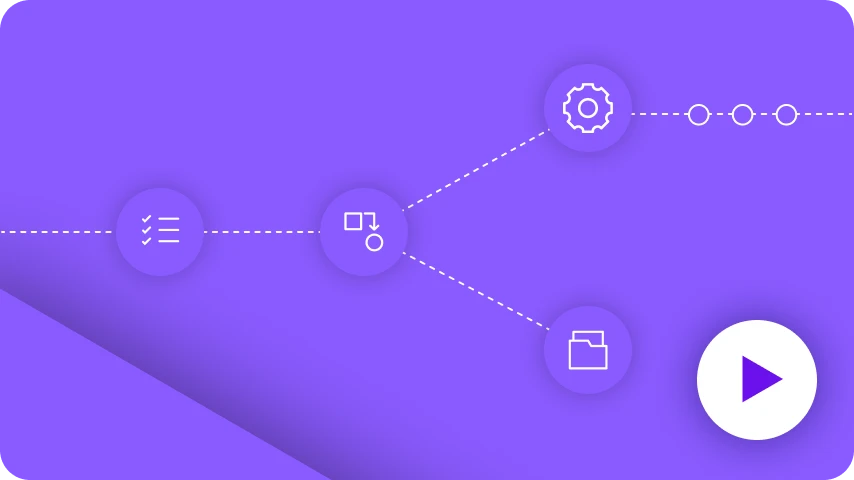
Saiba como o projeto de integração bem -sucedido do Vissimo Group através do Digibee resultou em vários benefícios e valor agregado para seus clientes.

Saiba como o projeto de integração bem -sucedido do Vissimo Group através do Digibee resultou em vários benefícios e valor agregado para seus clientes.

Começar com a integração empresarial é uma tarefa desafiadora; até mesmo o processo de planejar sua integração empresarial é uma tarefa difícil. Você sabe que é um grande trabalho, sabe que existem casos de uso complexos para mapear e considerar, e sabe que qualquer que seja a solução escolhida, ela deve ser capaz de se expandir e se adaptar à medida que sua empresa cresce (mesmo que você não saiba como sua empresa irá crescer!).
Se sua empresa já depende de software de empresas que também oferecem ferramentas de integração, à primeira vista, pode parecer que permanecer dentro desse ecossistema de software seja a maneira mais simples de garantir um plano de integração suave para os clientes e, no final, uma integração bem-sucedida.
À primeira vista, isso pode parecer verdade, e reconhecemos que a maioria dessas grandes empresas de software oferece plataformas de integração com funcionalidades muito robustas, capazes de atender às necessidades mais complexas dos usuários, mas existem vários desafios que precisam ser considerados em todas as áreas do ciclo de vida da integração, desde a construção, execução, monitoramento (…e faturamento!)
>> Agende uma demonstração personalizada com nossa equipe de especialistas e veja como a iPaaS da Digibee trará eficiência para o seu negócio.

Você já ouviu a expressão “Demais de algo bom”? Embora à primeira vista o tamanho e a complexidade das grandes plataformas de integração pareçam ser um benefício para qualquer usuário, isso pode causar várias situações imprevistas e adversas. Com um grande parceiro de integração muito complexo vem também uma grande conta mensal E um processo de certificação muito complexo.
Assim como em um buffet, onde você precisa ter um apetite grande o suficiente para justificar o seu gasto, ao escolher seu parceiro de integração você deve ter certeza de que o uso será alto o suficiente para compensar o preço elevado com um valor suficiente de integração. Até mesmo algumas grandes corporações correm o risco de gastar mais com a integração do que ganharam com ela, e isso se torna ainda mais perigoso para empresas de pequeno e médio porte, especialmente se elas sequer puderem arcar com o preço para começar!
Para aproveitar ao máximo um sistema complexo, muitas vezes é necessário contratar desenvolvedores especializados ou até mesmo passar por um processo formal de certificação para construí-lo e executá-lo. Para alcançar isso, uma empresa precisa gastar tempo e dinheiro contratando esses desenvolvedores especializados ou treinando seus próprios desenvolvedores internos para passar pelos três níveis de certificação antes de poderem até começar o processo de integração com os clientes empresariais.
É importante lembrar que esse treinamento será um custo contínuo, independentemente do caminho que você escolher. Isso também tornará o processo de substituir ou aumentar sua equipe à medida que você cresce mais lento e mais caro.
Acreditamos que é importante que empresas de todos os tamanhos comecem a integração, por isso, para apoiar esse objetivo, a Digibee adota uma abordagem muito flexível de precificação, sem uma barreira de entrada excessivamente alta. Em vez disso, usamos um modelo de assinatura que permite que você pague apenas pelas integrações que usar. O custo total da Digibee é, em média, quase 50% mais baixo do que o dos concorrentes e inclui cinco vezes o número de pipelines de produção – integrações facilmente replicáveis feitas entre sistemas – desde o início, para que você possa alcançar seus objetivos de integração mais rapidamente.
Na Digibee, também sabemos que o seu tempo até o valor é fundamental. Garantimos que sua equipe adquira maestria na plataforma Digibee sem abrir mão de resultados rápidos por meio de nosso plano de integração em 3 etapas:
A equipe Digibee entrega as primeiras integrações
Assinatura Digibee
Plataforma de Integração Digibee
Digibee / Cliente trabalham juntos para entregar
Assinatura Digibee
Plataforma de Integração Digibee, Entrega de Integração e Capacitação
O cliente está pronto para criar e entregar integrações
Assinatura Digibee
Plataforma de Integração Digibee e Equipe de Capacitação
No primeiro passo da integração do cliente, a Digibee construirá o primeiro conjunto de Pipelines para os nossos clientes. Ao fazer a equipe Digibee começar com suas primeiras integrações, você verá exemplos reais das cápsulas de integração Digibee em ação com sua própria suíte única de ferramentas internas e necessidades empresariais, oferecendo o tempo mais rápido possível para alcançar o mercado.
Para garantir que a Digibee seja realmente o melhor parceiro de integração para você, completamos o Passo 1 em qualquer uma das suas plataformas de testes, mesmo antes de você se comprometer com uma assinatura. Seu papel é simples: compartilhar o fluxo de dados e nos ajudar a conectar suas fontes de dados.
Na fase “Juntos”, você começa a construir suas próprias integrações com nosso suporte. Estaremos lá para orientar e educar sua equipe, tanto individualmente quanto por meio do portal Digibee Foundations Academy e Workshops.
Na Digibee, entendemos que “juntos” deve incluir tanto stakeholders técnicos quanto não técnicos. Dessa forma, todos terão uma compreensão adequada das capacidades de nossa plataforma de integração e poderão implementar de forma que atenda às suas necessidades empresariais.
Uma vez que sua equipe se sinta confortável, você estará pronto para seguir com novas integrações por conta própria. Graças às nossas soluções de arrastar e soltar de baixo código, até mesmo seus desenvolvedores mais juniores poderão aprender a construir, atualizar e executar integrações complexas rapidamente.
Nosso modelo de assinatura inclui vários bônus valiosos que apoiam sua jornada de integração com o cliente. Nossos serviços de suporte estão inclusos no preço, então não há custos ocultos.
Mesmo após sua integração estar em funcionamento com seus próprios desenvolvedores, estaremos sempre à disposição caso você precise! A Digibee oferece uma equipe dedicada de sucesso do cliente que ajudará você a solucionar problemas e capacitar sua equipe para continuar alcançando os melhores resultados e resultados com nossa plataforma de integração como serviço.
Usando métricas de monitoramento integradas e logs, nosso sistema apoia ativamente a manutenção da sua integração, sinalizando possíveis problemas em tempo real. Isso ajuda a evitar interrupções para seus clientes.
Com nosso modelo de assinatura e processo de integração em 3 etapas, a Digibee se esforça para tornar sua integração empresarial o mais simples e econômica possível.
Tem mais perguntas para nós? Confira este recurso: 5 (+1) Razões para Escolher a Digibee em vez de uma iPaaS Tradicional ou sinta-se à vontade para iniciar a conversa e agendar uma demonstração agora.

Entrega em menos de 30 dias no prazo da Black Friday, a Digibee garante uma plataforma de comércio eletrônico para um varejista global.

Os varejistas estão firmemente a bordo do trem da transformação digital, reinventando a forma como fazem negócios para encantar os consumidores com experiências omnichannel e personalizadas. Foram embora as pilhas de tecnologia monolíticas, substituídas por modelos de arquitetura ágeis e arquiteturas compostáveis que suportam o sucesso dos negócios hoje e no futuro.
No entanto, na pressa de digitalizar, muitos varejistas negligenciam os volumes sem precedentes de dados que essas novas (e existentes) tecnologias geram. Embora muito pensamento seja investido em otimizar a experiência do cliente (CX), estabelecer como gerenciar o armazenamento e a análise de tantos dados muitas vezes acaba sendo uma reflexão posterior.
Neste post, examinamos os diferentes tipos de dados gerados no varejo, as novas tecnologias que aumentam a carga e a importância estratégica de gerenciar dados para um negócio saudável e lucrativo.
>> Agende uma demonstração personalizada com nossa equipe de especialistas e veja como o iPaaS da Digibee pode trazer eficiência para o seu negócio.
Os varejistas geram dados em toda a operação, tanto na frente quanto atrás. Cada escolha, clique e interação com o cliente; cada SKU, venda e mudança de estoque gera mais dados que precisam ser gerenciados.
Existem três categorias de dados no varejo, dependendo da fonte:
Uma vez combinados, o conjunto é referido como Big Data, com ênfase no “grande”.
Considere o maior varejista do mundo: Walmart. A empresa coleta 2,5 petabytes de dados não estruturados de um milhão de clientes a cada hora. Acrescente a isso os dados gerados por 245 milhões de clientes que visitam 10.900 lojas físicas, complementados por 10 sites ativos, e a magnitude do Big Data da empresa é impressionante.
As informações coletadas servem bem ao Walmart. Por exemplo, os sistemas de análise internos analisam quase 100 milhões de palavras-chave todos os dias para otimizar os lances, levando em consideração milhões de produtos e centenas de milhões de clientes de uma variedade de fontes. Somente nessa iniciativa de dados, o Walmart obteve um aumento de 10-15% nas vendas online, gerando $1 bilhão em receita incremental.
Embora poucas empresas compitam no nível do Walmart, a necessidade de coletar e integrar dados de uma variedade de componentes geradores de dados é uma exigência absoluta para a transformação digital, independentemente do tamanho do varejista.
A integração empresarial é um facilitador crítico para alcançar esses resultados, agilizando a coleta de dados estruturados, não estruturados e semi-estruturados em toda a operação, contribuindo para um coletivo de Big Data.
Um bom exemplo é Payless, uma cadeia internacional de calçados self-service, com quase 4.500 lojas em 30 países. O varejista implementou a tecnologia de plataforma de integração empresarial como serviço (eiPaaS) para conectar uma nova plataforma de e-commerce à sua infraestrutura de varejo existente.
O resultado é um fluxo contínuo de dados de e para o sistema, apoiando um banco de dados consolidado para melhores análises e insights. Com uma plataforma de e-commerce contemporânea operando perfeitamente, a Payless é capaz de fornecer uma experiência de cliente aprimorada, mesmo durante picos de vendas na Black Friday e outros dias de alto volume.
Com a integração empresarial, os varejistas se beneficiam de um rico repositório de dados sempre atualizados que podem ser analisados continuamente para descobrir insights significativos. Estes incluem:
Mesmo após colocar sua casa de dados em ordem, o trabalho não para. Mais clientes significam mais interações digitais, gerando ainda mais dados. O mais impactante é a adoção de tecnologias emergentes, um facilitador chave para as iniciativas de transformação digital.
Hoje, sites de e-commerce e interações remotas geram a maior parte dos dados no varejo. No entanto, lojas físicas se tornaram geradoras de dados por si mesmas. Aqui estão apenas alguns exemplos de tecnologias inovadoras em lojas físicas que contribuem para o Big Data:
A loja Nike NYC House of Innovation oferece aos clientes uma experiência imersiva, digitalmente poderosa, incluindo geozonas interativas que são navegadas por meio de códigos QR escaneados em celulares.
(Crédito da foto: Nike)
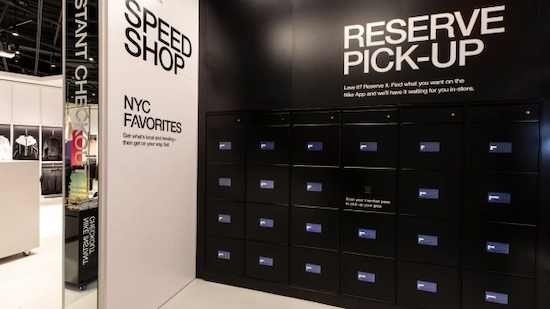
O espaço inclui a Nike Speed Shop, onde os clientes reservam itens online, depois experimentam e compram na loja. Mercadorias pré-selecionadas são colocadas em armários que os clientes abrem com seu smartphone.
A loja também possui um espaço de personalização onde os compradores personalizam produtos com as cores e características que desejam.
Todos estão familiarizados (talvez nem tanto empolgados) com os quiosques de autoatendimento. O checkout automatizado está aprimorando a experiência, com visão computacional, aprendizado profundo e tecnologia de fusão de sensores para automatizar pagamento e finalização da compra.
(Crédito da foto: Amazon)
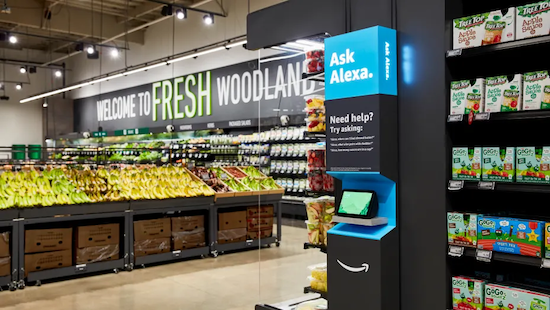
Amazon é um dos pioneiros, onde os clientes entram na loja, selecionam os itens e saem sem filas ou checkout. O pagamento é automatizado pelo app Amazon Go.
A adoção de novas tecnologias não se limita às interações com o cliente. O Sam’s Club depende de robôs automatizados com sistemas operacionais de inteligência artificial para analisar as unidades de estantes em suas lojas.
(Crédito da foto: Sam’s Club)
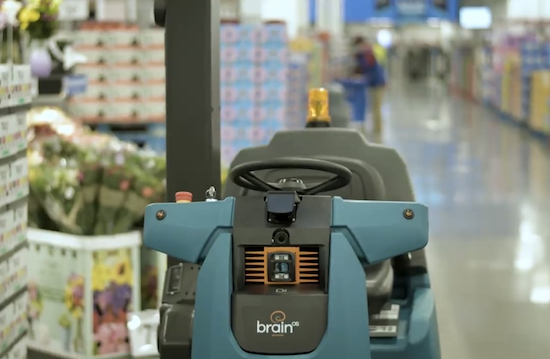
Os dados coletados são usados para verificar a precisão dos preços, confirmar a localização dos produtos em relação ao layout da loja e monitorar os níveis de estoque.
Embora radicalmente diferentes em termos de tecnologia e casos de uso, todos esses modelos inovadores de tecnologia no varejo têm uma coisa em comum: dados. E muitos dados.
Gerenciar tantas fontes de dados diversas tornou-se uma necessidade empresarial, fornecendo às organizações de varejo insights que ajudam a informar decisões importantes, hoje e no futuro.
A tecnologia eiPaaS da Digibee permite uma estratégia de dados resiliente e ágil que cresce facilmente com sua organização, independentemente do tamanho ou escala. Ajudamos nossos clientes a evoluir seus negócios, aproveitando o eiPaaS low-code da Digibee para integrar sistemas modernos com tecnologias existentes, agilizando o fluxo de dados em toda a operação para uma visão única dos negócios.
Se você estiver interessado em como a Digibee pode ajudar sua organização de varejo, temos prazer em mostrar como. Agende sua escolha de uma ligação de descoberta (15 minutos), demonstração personalizada (30 minutos) ou uma análise aprofundada (60 minutos) para saber mais.

A Digibee forneceu ao Grupo Weir um processo de integração rápido, confiável e seguro para dar suporte a fluxos de trabalho críticos.

Antes descartada como uma palavra da moda sem significado entre os círculos tecnológicos, a transformação digital se tornou uma prioridade para organizações de todos os tamanhos e em todos os setores.
A importância de adaptar sistemas legados muitas vezes isolados para se comunicarem com novas tecnologias e ferramentas ficou dolorosamente clara durante os bloqueios da pandemia, e a nova realidade de modelos híbridos de trabalho e negócios digitais forçou até mesmo os mais resistentes à mudança a reconhecer seu valor.
Mas o que é a transformação digital, realmente?
>> Agende uma demonstração personalizada com nossa equipe de especialistas e veja como o iPaaS da Digibee trará eficiência para o seu negócio.
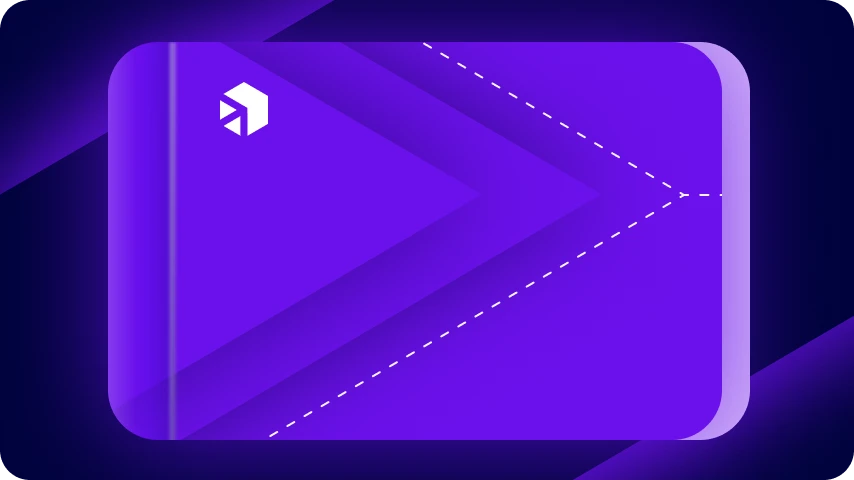
Compara o amplo investimento e o impacto no valor comercial de uma integração “faça você mesmo” com a eficiência e o valor entregue usando o eiPaaS da Digibee.

Os seus sonhos de cifrões estão se transformando em pesadelos enquanto você observa seus projetos de integração de TI arrastando-se por meses (ou o que parece ser anos)?
Você pode ter inicialmente pensado que uma solução de integração tradicional seria a bala de prata para resolver todos os seus problemas de TI, mas agora está percebendo que talvez tenha errado ao escolher um único provedor de integração.
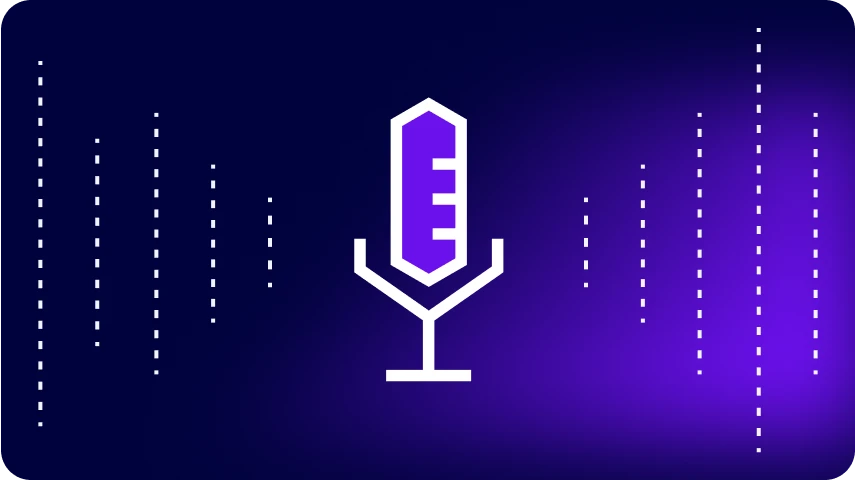
Discussão com Johnny Russo, diretor digital da Lamour, sobre transformação digital e liderança consciente.

Ao concluirmos o Mês da História Negra e entrarmos no Mês da História das Mulheres, temos a sorte de compartilhar a história de uma mulher e líder negra notável em nossa equipe, nossa Chief People Officer (CPO), Tia Phillips. Leia sobre por que ela escolheu a Digibee e o trabalho emocionante que está por vir para a nossa equipe de Pessoas.
De minha casa em Massachusetts, até a casa dela do outro lado dos EUA, na Califórnia, tive uma conversa verdadeiramente agradável com esta otimista perpétua, entusiasta de Star Trek, amante da natureza, líder inspiradora, defensora da diversidade e dedicada mãe de lacrosse. (E esses são apenas alguns dos jeitos de descrever nossa CPO infinitamente legal!)

Os desenvolvedores profissionais da sua equipe estão passando todo o tempo escrevendo códigos tediosos para integrações de TI internas? Ou talvez eles estejam gastando centenas de horas em treinamentos e certificações para soluções tradicionais de plataforma de integração corporativa como serviço (enterprise iPaaS), quando poderiam estar dedicando seu tempo valioso em atividades mais importantes para a empresa.
Ao contemplar sua estratégia de integração corporativa, você precisa considerar todos os fatores envolvidos. Isso pode incluir as habilidades técnicas de sua equipe atual, os recursos disponíveis, o impacto econômico total do projeto e o retorno sobre investimento da plataforma (ROI), e quanto tempo você pode dedicar ao projeto de integração de TI – em cada etapa do processo ‘construir, executar, monitorar’.
Ao desenvolver sua estratégia de integração, um dos primeiros passos é determinar qual tipo de solução de integração de TI é a melhor para o seu negócio.
>> Agende uma demonstração personalizada com nossa equipe de especialistas e veja como o iPaaS da Digibee trará eficiência para o seu negócio.
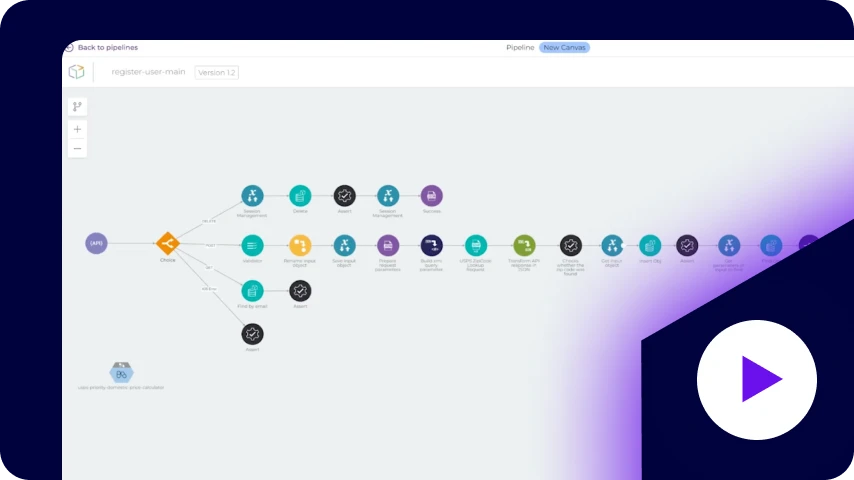
Saiba como a Digibee ajudou o Grupo Víssimo a integrar sua plataforma legada a uma plataforma de mercado em tempo recorde e com excelente suporte.
X